HC1072 Economics and International Trade: Housing Industry Report
VerifiedAdded on 2022/11/15
|17
|2867
|85
Report
AI Summary
This report provides a comprehensive analysis of the Australian housing industry, examining various aspects such as revenue, industrial growth, and market structure. It delves into the industry's background, including its performance during economic fluctuations and its contribution to the country's GDP. The report explores the factors influencing both demand and supply within the housing market, including population growth, income levels, interest rates, and foreign investment. It also addresses the concept of elasticity in the housing market and the impacts of price drops on the industry. The report highlights key market leaders and provides a detailed overview of the industry's current state and future prospects, supported by statistical data and references.
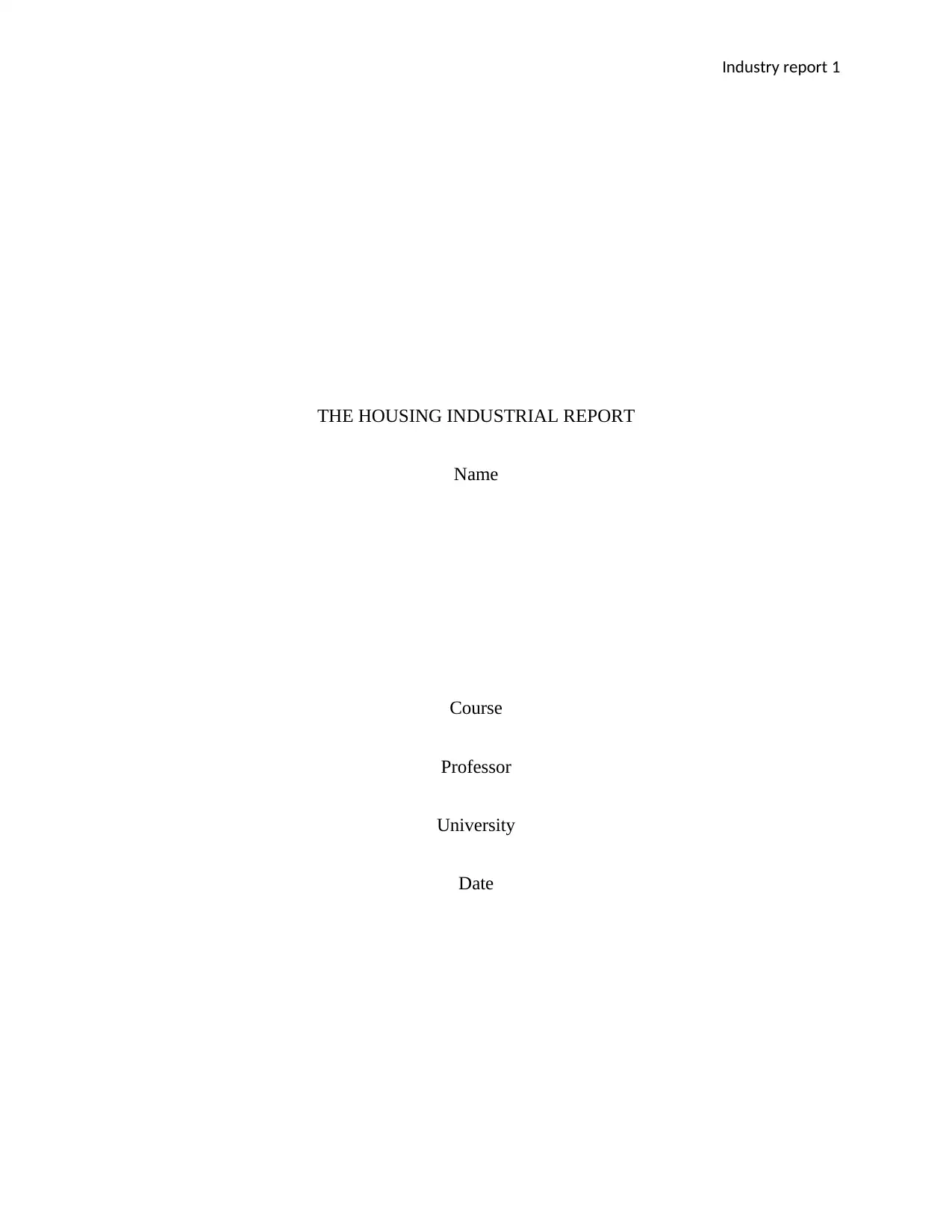
Industry report 1
THE HOUSING INDUSTRIAL REPORT
Name
Course
Professor
University
Date
THE HOUSING INDUSTRIAL REPORT
Name
Course
Professor
University
Date
Paraphrase This Document
Need a fresh take? Get an instant paraphrase of this document with our AI Paraphraser
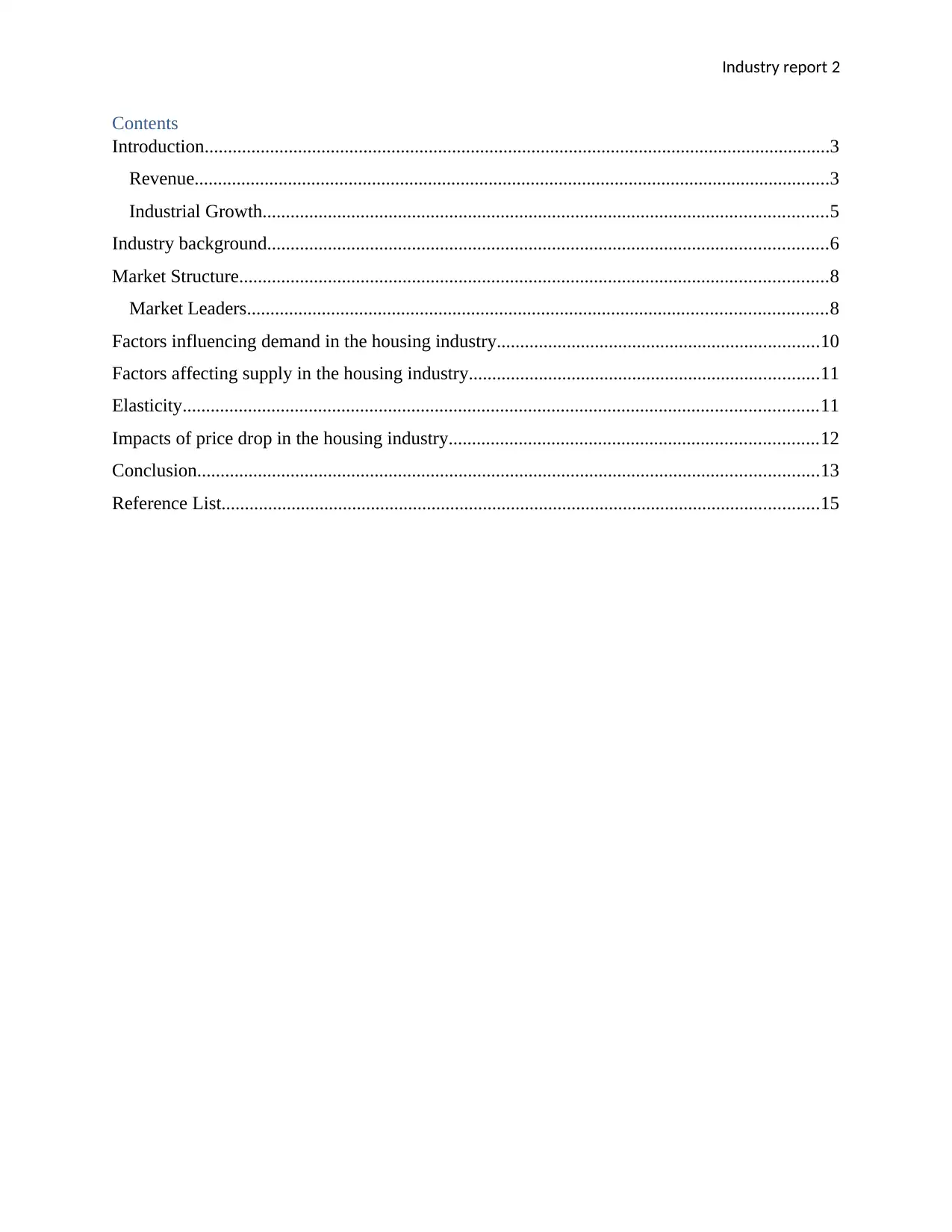
Industry report 2
Contents
Introduction......................................................................................................................................3
Revenue........................................................................................................................................3
Industrial Growth.........................................................................................................................5
Industry background........................................................................................................................6
Market Structure..............................................................................................................................8
Market Leaders............................................................................................................................8
Factors influencing demand in the housing industry.....................................................................10
Factors affecting supply in the housing industry...........................................................................11
Elasticity........................................................................................................................................11
Impacts of price drop in the housing industry...............................................................................12
Conclusion.....................................................................................................................................13
Reference List................................................................................................................................15
Contents
Introduction......................................................................................................................................3
Revenue........................................................................................................................................3
Industrial Growth.........................................................................................................................5
Industry background........................................................................................................................6
Market Structure..............................................................................................................................8
Market Leaders............................................................................................................................8
Factors influencing demand in the housing industry.....................................................................10
Factors affecting supply in the housing industry...........................................................................11
Elasticity........................................................................................................................................11
Impacts of price drop in the housing industry...............................................................................12
Conclusion.....................................................................................................................................13
Reference List................................................................................................................................15
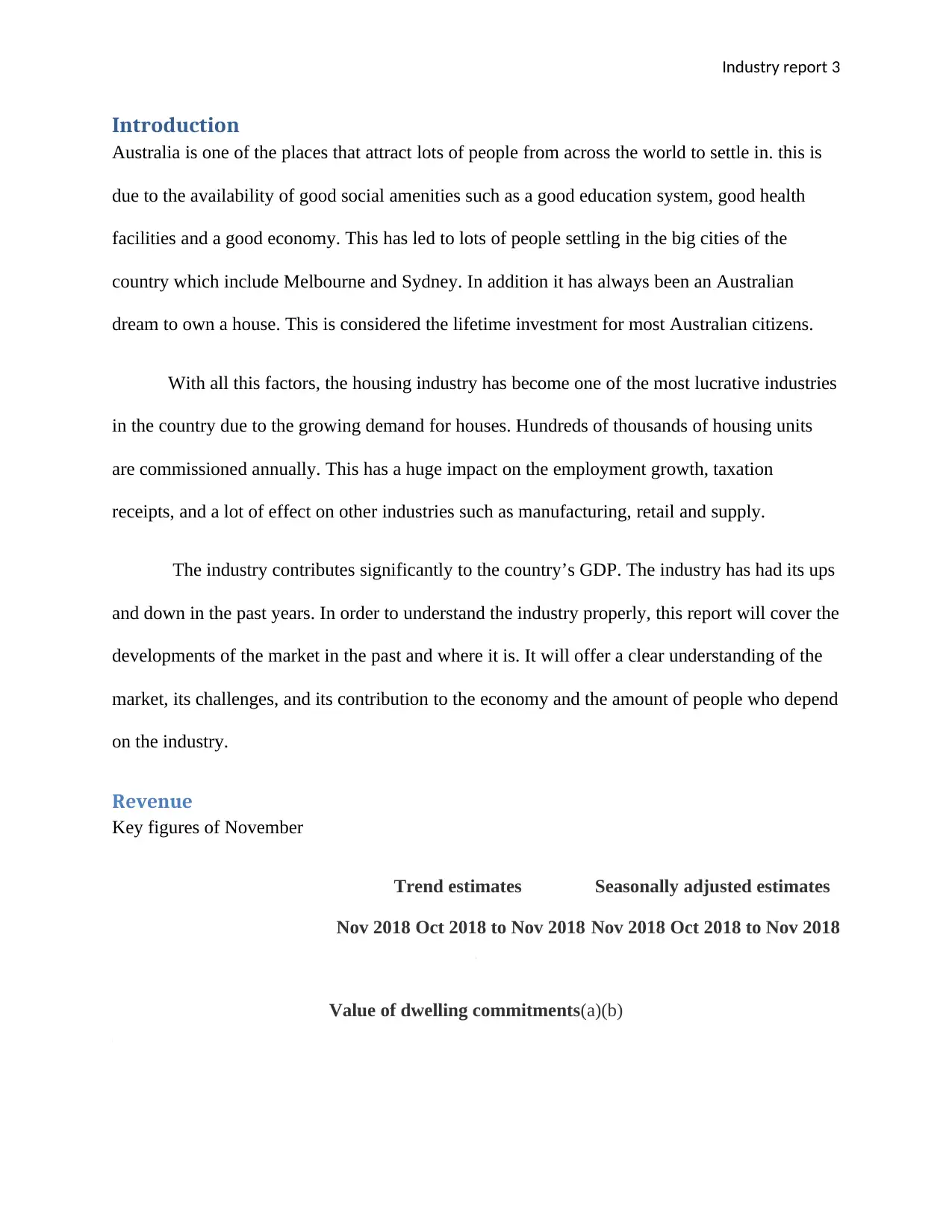
Industry report 3
Introduction
Australia is one of the places that attract lots of people from across the world to settle in. this is
due to the availability of good social amenities such as a good education system, good health
facilities and a good economy. This has led to lots of people settling in the big cities of the
country which include Melbourne and Sydney. In addition it has always been an Australian
dream to own a house. This is considered the lifetime investment for most Australian citizens.
With all this factors, the housing industry has become one of the most lucrative industries
in the country due to the growing demand for houses. Hundreds of thousands of housing units
are commissioned annually. This has a huge impact on the employment growth, taxation
receipts, and a lot of effect on other industries such as manufacturing, retail and supply.
The industry contributes significantly to the country’s GDP. The industry has had its ups
and down in the past years. In order to understand the industry properly, this report will cover the
developments of the market in the past and where it is. It will offer a clear understanding of the
market, its challenges, and its contribution to the economy and the amount of people who depend
on the industry.
Revenue
Key figures of November
Trend estimates Seasonally adjusted estimates
Nov 2018 Oct 2018 to Nov 2018 Nov 2018 Oct 2018 to Nov 2018
Value of dwelling commitments(a)(b)
Introduction
Australia is one of the places that attract lots of people from across the world to settle in. this is
due to the availability of good social amenities such as a good education system, good health
facilities and a good economy. This has led to lots of people settling in the big cities of the
country which include Melbourne and Sydney. In addition it has always been an Australian
dream to own a house. This is considered the lifetime investment for most Australian citizens.
With all this factors, the housing industry has become one of the most lucrative industries
in the country due to the growing demand for houses. Hundreds of thousands of housing units
are commissioned annually. This has a huge impact on the employment growth, taxation
receipts, and a lot of effect on other industries such as manufacturing, retail and supply.
The industry contributes significantly to the country’s GDP. The industry has had its ups
and down in the past years. In order to understand the industry properly, this report will cover the
developments of the market in the past and where it is. It will offer a clear understanding of the
market, its challenges, and its contribution to the economy and the amount of people who depend
on the industry.
Revenue
Key figures of November
Trend estimates Seasonally adjusted estimates
Nov 2018 Oct 2018 to Nov 2018 Nov 2018 Oct 2018 to Nov 2018
Value of dwelling commitments(a)(b)
⊘ This is a preview!⊘
Do you want full access?
Subscribe today to unlock all pages.

Trusted by 1+ million students worldwide
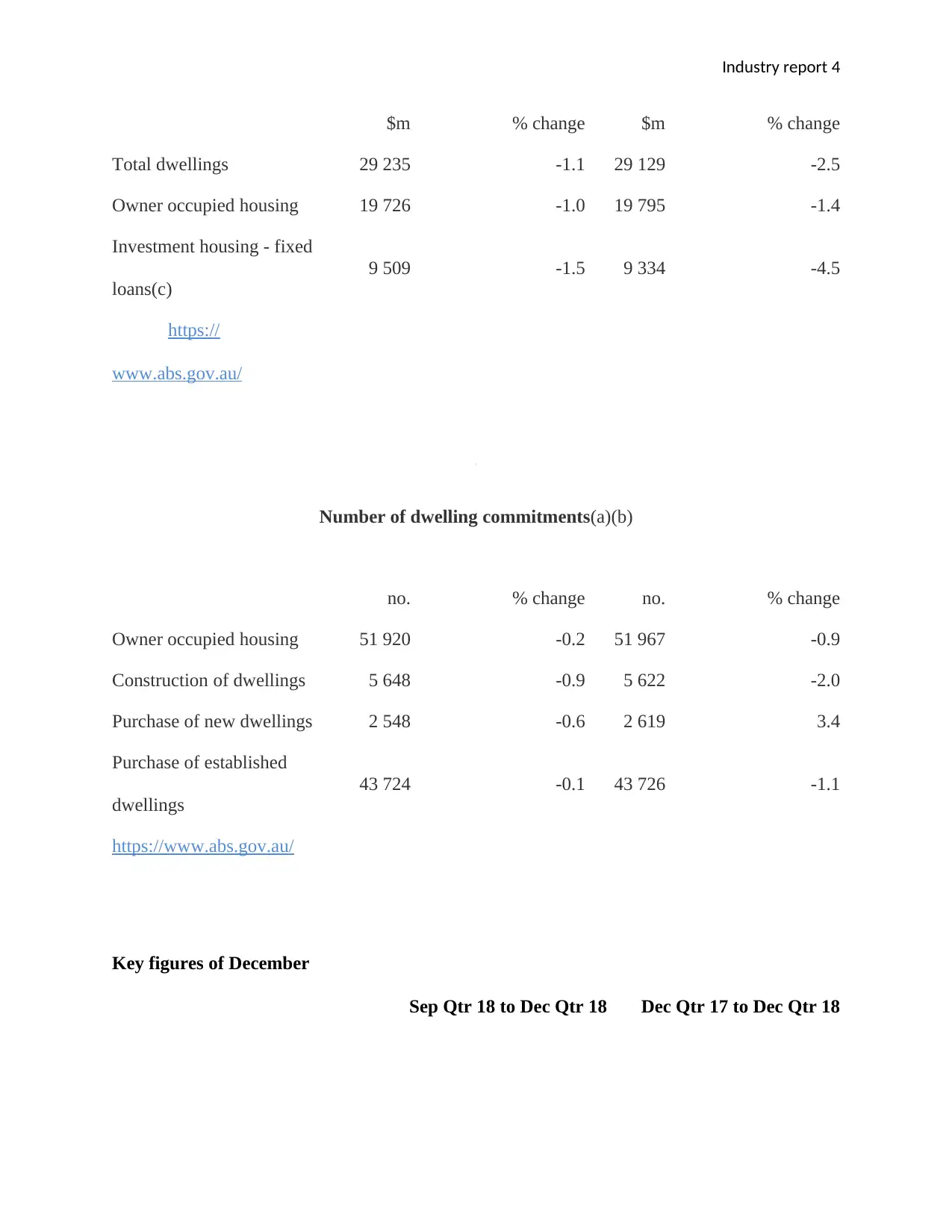
Industry report 4
$m % change $m % change
Total dwellings 29 235 -1.1 29 129 -2.5
Owner occupied housing 19 726 -1.0 19 795 -1.4
Investment housing - fixed
loans(c)
9 509 -1.5 9 334 -4.5
https://
www.abs.gov.au/
Number of dwelling commitments(a)(b)
no. % change no. % change
Owner occupied housing 51 920 -0.2 51 967 -0.9
Construction of dwellings 5 648 -0.9 5 622 -2.0
Purchase of new dwellings 2 548 -0.6 2 619 3.4
Purchase of established
dwellings
43 724 -0.1 43 726 -1.1
https://www.abs.gov.au/
Key figures of December
Sep Qtr 18 to Dec Qtr 18 Dec Qtr 17 to Dec Qtr 18
$m % change $m % change
Total dwellings 29 235 -1.1 29 129 -2.5
Owner occupied housing 19 726 -1.0 19 795 -1.4
Investment housing - fixed
loans(c)
9 509 -1.5 9 334 -4.5
https://
www.abs.gov.au/
Number of dwelling commitments(a)(b)
no. % change no. % change
Owner occupied housing 51 920 -0.2 51 967 -0.9
Construction of dwellings 5 648 -0.9 5 622 -2.0
Purchase of new dwellings 2 548 -0.6 2 619 3.4
Purchase of established
dwellings
43 724 -0.1 43 726 -1.1
https://www.abs.gov.au/
Key figures of December
Sep Qtr 18 to Dec Qtr 18 Dec Qtr 17 to Dec Qtr 18
Paraphrase This Document
Need a fresh take? Get an instant paraphrase of this document with our AI Paraphraser
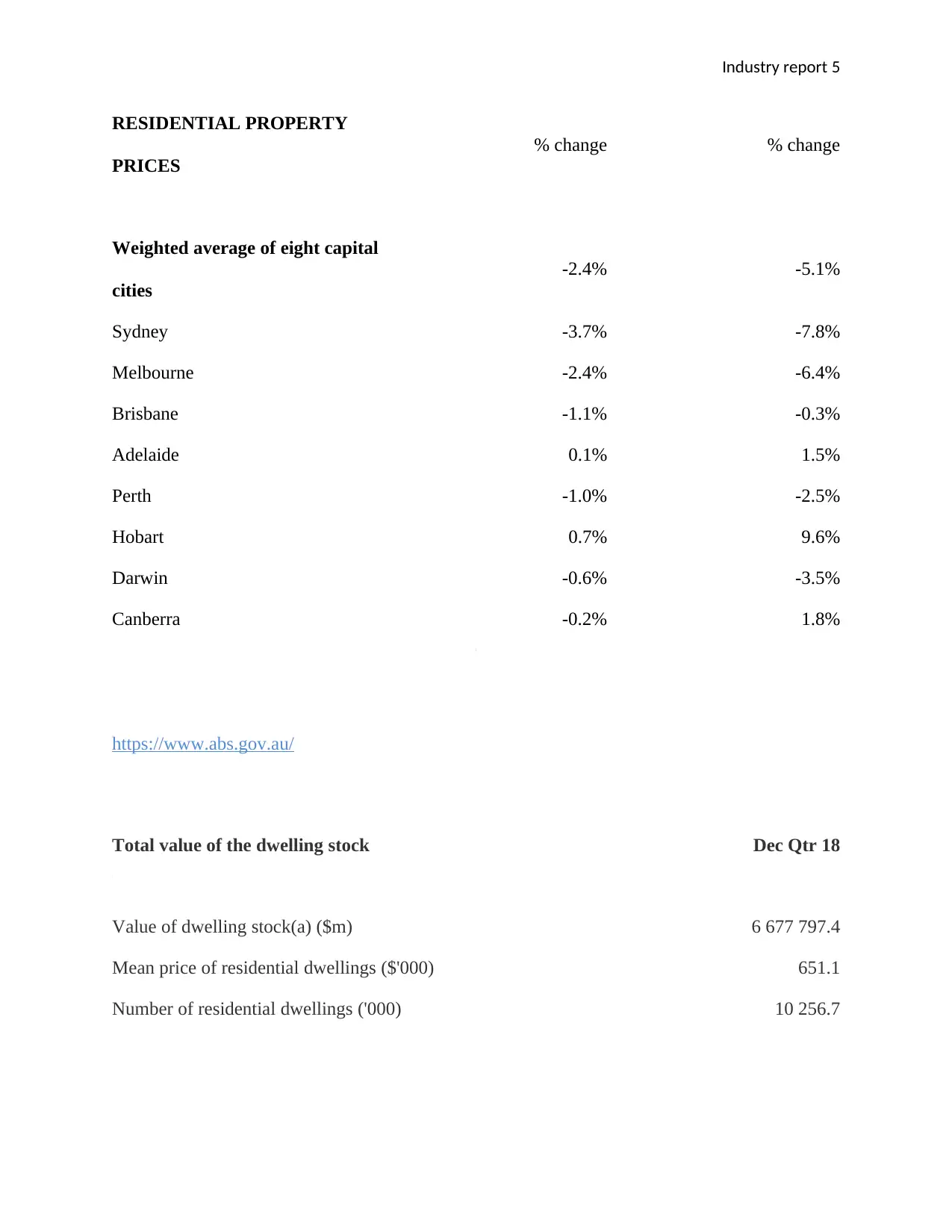
Industry report 5
RESIDENTIAL PROPERTY
PRICES
% change % change
Weighted average of eight capital
cities
-2.4% -5.1%
Sydney -3.7% -7.8%
Melbourne -2.4% -6.4%
Brisbane -1.1% -0.3%
Adelaide 0.1% 1.5%
Perth -1.0% -2.5%
Hobart 0.7% 9.6%
Darwin -0.6% -3.5%
Canberra -0.2% 1.8%
https://www.abs.gov.au/
Total value of the dwelling stock Dec Qtr 18
Value of dwelling stock(a) ($m) 6 677 797.4
Mean price of residential dwellings ($'000) 651.1
Number of residential dwellings ('000) 10 256.7
RESIDENTIAL PROPERTY
PRICES
% change % change
Weighted average of eight capital
cities
-2.4% -5.1%
Sydney -3.7% -7.8%
Melbourne -2.4% -6.4%
Brisbane -1.1% -0.3%
Adelaide 0.1% 1.5%
Perth -1.0% -2.5%
Hobart 0.7% 9.6%
Darwin -0.6% -3.5%
Canberra -0.2% 1.8%
https://www.abs.gov.au/
Total value of the dwelling stock Dec Qtr 18
Value of dwelling stock(a) ($m) 6 677 797.4
Mean price of residential dwellings ($'000) 651.1
Number of residential dwellings ('000) 10 256.7
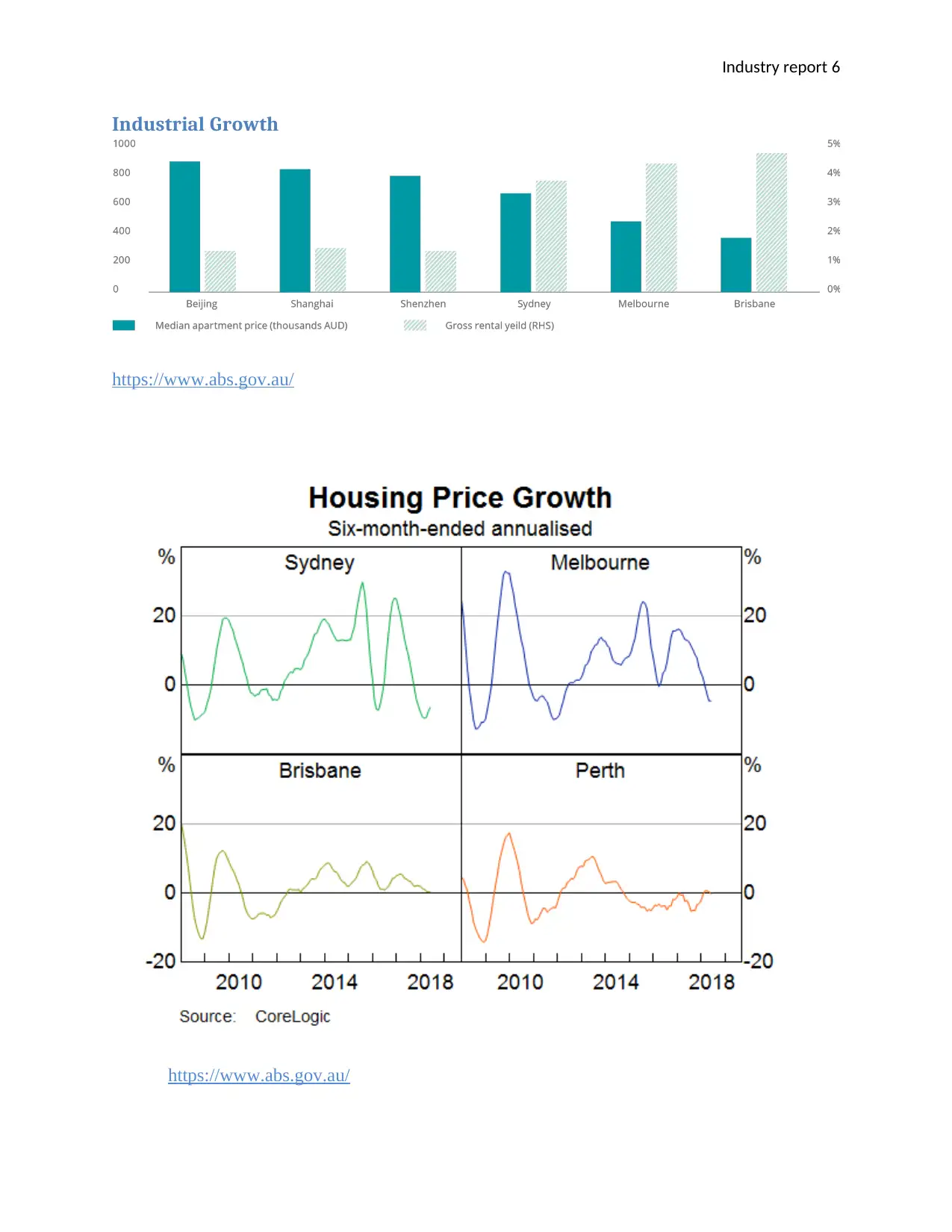
Industry report 6
Industrial Growth
https://www.abs.gov.au/
https://www.abs.gov.au/
Industrial Growth
https://www.abs.gov.au/
https://www.abs.gov.au/
⊘ This is a preview!⊘
Do you want full access?
Subscribe today to unlock all pages.

Trusted by 1+ million students worldwide
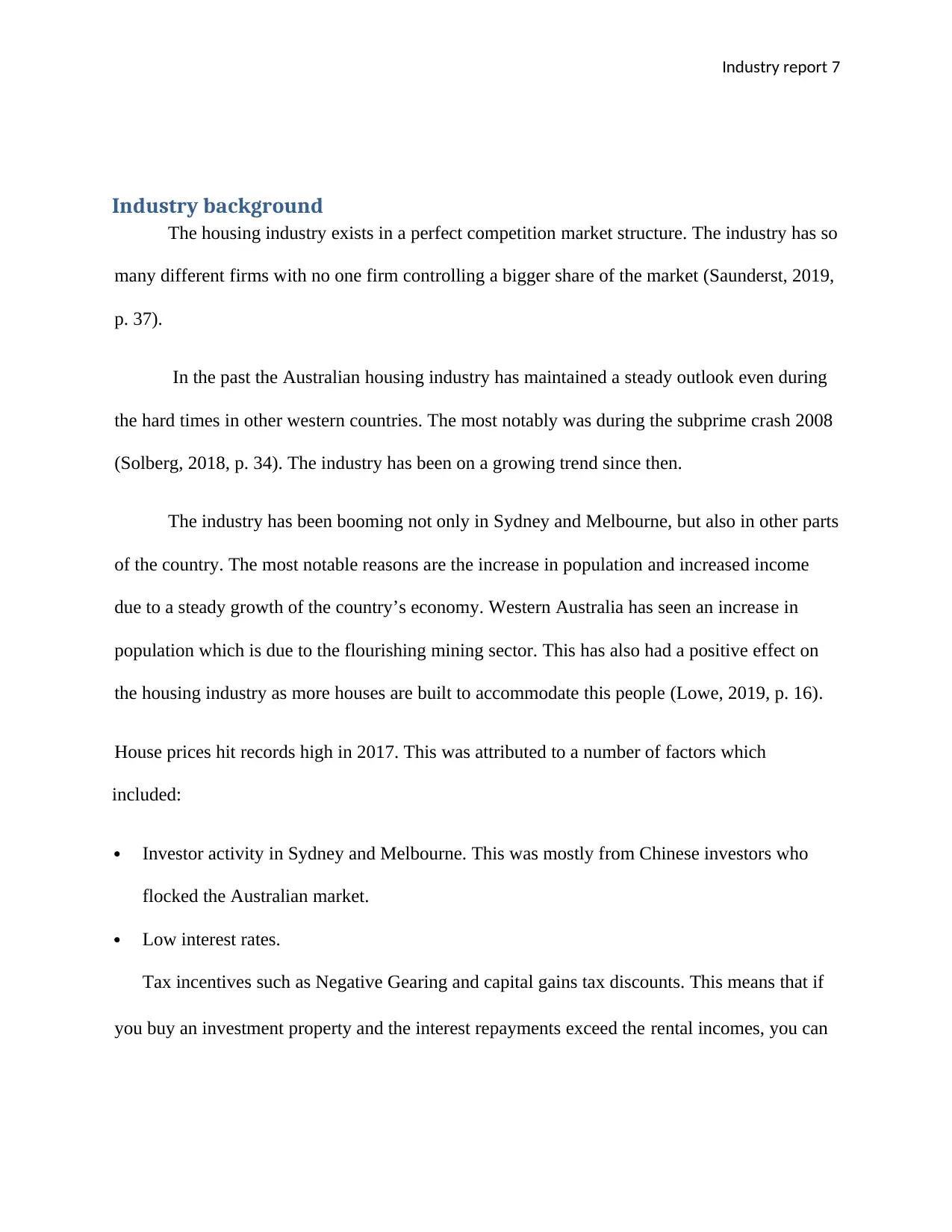
Industry report 7
Industry background
The housing industry exists in a perfect competition market structure. The industry has so
many different firms with no one firm controlling a bigger share of the market (Saunderst, 2019,
p. 37).
In the past the Australian housing industry has maintained a steady outlook even during
the hard times in other western countries. The most notably was during the subprime crash 2008
(Solberg, 2018, p. 34). The industry has been on a growing trend since then.
The industry has been booming not only in Sydney and Melbourne, but also in other parts
of the country. The most notable reasons are the increase in population and increased income
due to a steady growth of the country’s economy. Western Australia has seen an increase in
population which is due to the flourishing mining sector. This has also had a positive effect on
the housing industry as more houses are built to accommodate this people (Lowe, 2019, p. 16).
House prices hit records high in 2017. This was attributed to a number of factors which
included:
Investor activity in Sydney and Melbourne. This was mostly from Chinese investors who
flocked the Australian market.
Low interest rates.
Tax incentives such as Negative Gearing and capital gains tax discounts. This means that if
you buy an investment property and the interest repayments exceed the rental incomes, you can
Industry background
The housing industry exists in a perfect competition market structure. The industry has so
many different firms with no one firm controlling a bigger share of the market (Saunderst, 2019,
p. 37).
In the past the Australian housing industry has maintained a steady outlook even during
the hard times in other western countries. The most notably was during the subprime crash 2008
(Solberg, 2018, p. 34). The industry has been on a growing trend since then.
The industry has been booming not only in Sydney and Melbourne, but also in other parts
of the country. The most notable reasons are the increase in population and increased income
due to a steady growth of the country’s economy. Western Australia has seen an increase in
population which is due to the flourishing mining sector. This has also had a positive effect on
the housing industry as more houses are built to accommodate this people (Lowe, 2019, p. 16).
House prices hit records high in 2017. This was attributed to a number of factors which
included:
Investor activity in Sydney and Melbourne. This was mostly from Chinese investors who
flocked the Australian market.
Low interest rates.
Tax incentives such as Negative Gearing and capital gains tax discounts. This means that if
you buy an investment property and the interest repayments exceed the rental incomes, you can
Paraphrase This Document
Need a fresh take? Get an instant paraphrase of this document with our AI Paraphraser
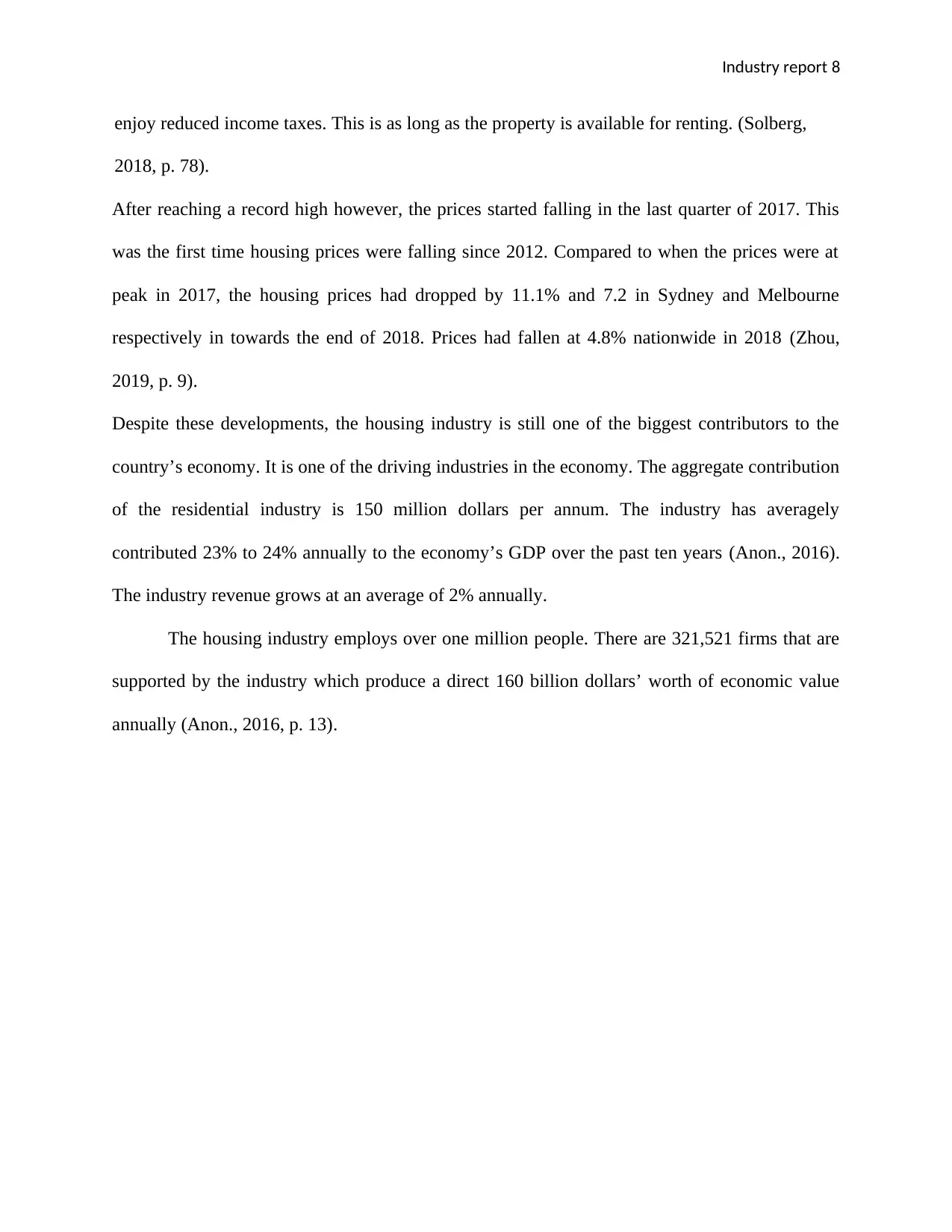
Industry report 8
enjoy reduced income taxes. This is as long as the property is available for renting. (Solberg,
2018, p. 78).
After reaching a record high however, the prices started falling in the last quarter of 2017. This
was the first time housing prices were falling since 2012. Compared to when the prices were at
peak in 2017, the housing prices had dropped by 11.1% and 7.2 in Sydney and Melbourne
respectively in towards the end of 2018. Prices had fallen at 4.8% nationwide in 2018 (Zhou,
2019, p. 9).
Despite these developments, the housing industry is still one of the biggest contributors to the
country’s economy. It is one of the driving industries in the economy. The aggregate contribution
of the residential industry is 150 million dollars per annum. The industry has averagely
contributed 23% to 24% annually to the economy’s GDP over the past ten years (Anon., 2016).
The industry revenue grows at an average of 2% annually.
The housing industry employs over one million people. There are 321,521 firms that are
supported by the industry which produce a direct 160 billion dollars’ worth of economic value
annually (Anon., 2016, p. 13).
enjoy reduced income taxes. This is as long as the property is available for renting. (Solberg,
2018, p. 78).
After reaching a record high however, the prices started falling in the last quarter of 2017. This
was the first time housing prices were falling since 2012. Compared to when the prices were at
peak in 2017, the housing prices had dropped by 11.1% and 7.2 in Sydney and Melbourne
respectively in towards the end of 2018. Prices had fallen at 4.8% nationwide in 2018 (Zhou,
2019, p. 9).
Despite these developments, the housing industry is still one of the biggest contributors to the
country’s economy. It is one of the driving industries in the economy. The aggregate contribution
of the residential industry is 150 million dollars per annum. The industry has averagely
contributed 23% to 24% annually to the economy’s GDP over the past ten years (Anon., 2016).
The industry revenue grows at an average of 2% annually.
The housing industry employs over one million people. There are 321,521 firms that are
supported by the industry which produce a direct 160 billion dollars’ worth of economic value
annually (Anon., 2016, p. 13).
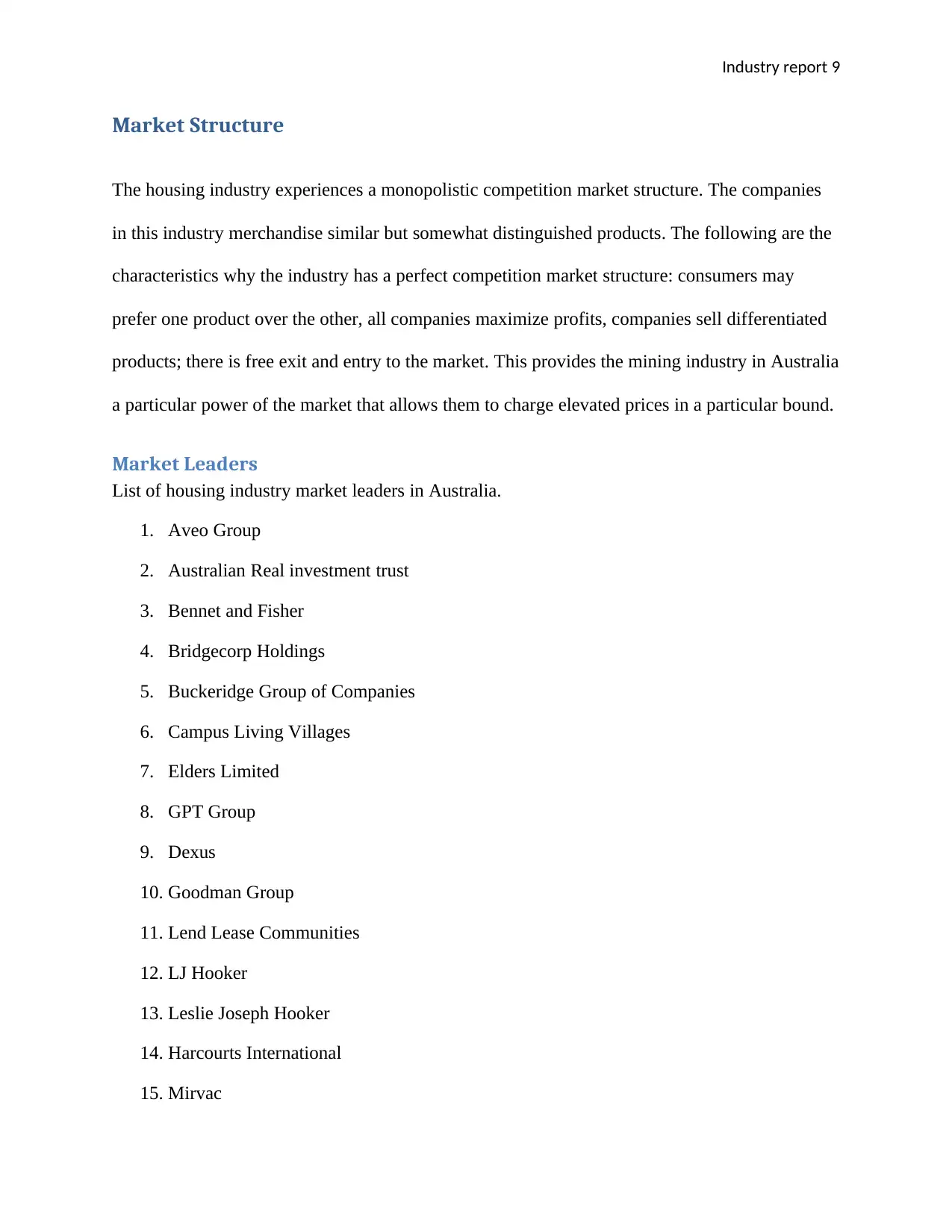
Industry report 9
Market Structure
The housing industry experiences a monopolistic competition market structure. The companies
in this industry merchandise similar but somewhat distinguished products. The following are the
characteristics why the industry has a perfect competition market structure: consumers may
prefer one product over the other, all companies maximize profits, companies sell differentiated
products; there is free exit and entry to the market. This provides the mining industry in Australia
a particular power of the market that allows them to charge elevated prices in a particular bound.
Market Leaders
List of housing industry market leaders in Australia.
1. Aveo Group
2. Australian Real investment trust
3. Bennet and Fisher
4. Bridgecorp Holdings
5. Buckeridge Group of Companies
6. Campus Living Villages
7. Elders Limited
8. GPT Group
9. Dexus
10. Goodman Group
11. Lend Lease Communities
12. LJ Hooker
13. Leslie Joseph Hooker
14. Harcourts International
15. Mirvac
Market Structure
The housing industry experiences a monopolistic competition market structure. The companies
in this industry merchandise similar but somewhat distinguished products. The following are the
characteristics why the industry has a perfect competition market structure: consumers may
prefer one product over the other, all companies maximize profits, companies sell differentiated
products; there is free exit and entry to the market. This provides the mining industry in Australia
a particular power of the market that allows them to charge elevated prices in a particular bound.
Market Leaders
List of housing industry market leaders in Australia.
1. Aveo Group
2. Australian Real investment trust
3. Bennet and Fisher
4. Bridgecorp Holdings
5. Buckeridge Group of Companies
6. Campus Living Villages
7. Elders Limited
8. GPT Group
9. Dexus
10. Goodman Group
11. Lend Lease Communities
12. LJ Hooker
13. Leslie Joseph Hooker
14. Harcourts International
15. Mirvac
⊘ This is a preview!⊘
Do you want full access?
Subscribe today to unlock all pages.

Trusted by 1+ million students worldwide
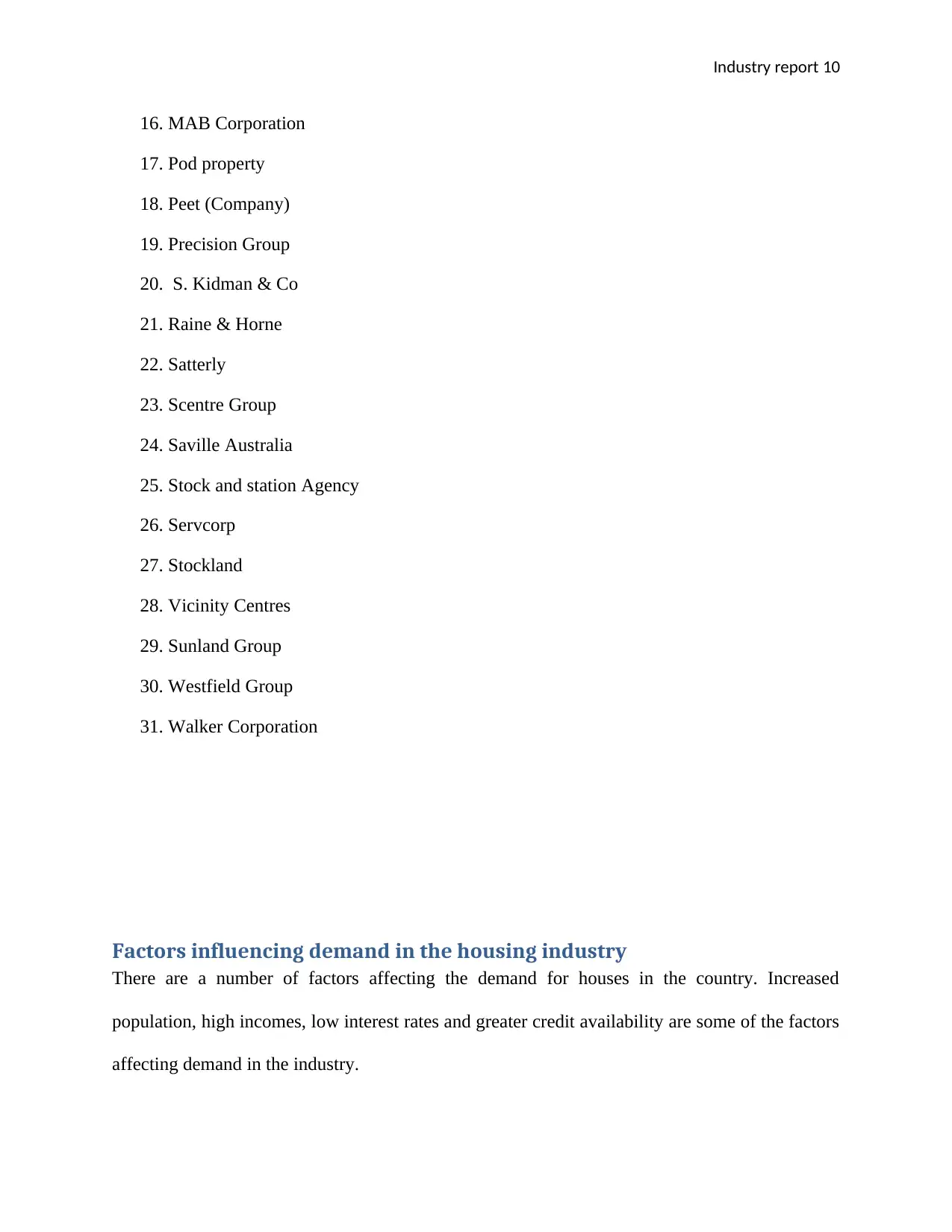
Industry report 10
16. MAB Corporation
17. Pod property
18. Peet (Company)
19. Precision Group
20. S. Kidman & Co
21. Raine & Horne
22. Satterly
23. Scentre Group
24. Saville Australia
25. Stock and station Agency
26. Servcorp
27. Stockland
28. Vicinity Centres
29. Sunland Group
30. Westfield Group
31. Walker Corporation
Factors influencing demand in the housing industry
There are a number of factors affecting the demand for houses in the country. Increased
population, high incomes, low interest rates and greater credit availability are some of the factors
affecting demand in the industry.
16. MAB Corporation
17. Pod property
18. Peet (Company)
19. Precision Group
20. S. Kidman & Co
21. Raine & Horne
22. Satterly
23. Scentre Group
24. Saville Australia
25. Stock and station Agency
26. Servcorp
27. Stockland
28. Vicinity Centres
29. Sunland Group
30. Westfield Group
31. Walker Corporation
Factors influencing demand in the housing industry
There are a number of factors affecting the demand for houses in the country. Increased
population, high incomes, low interest rates and greater credit availability are some of the factors
affecting demand in the industry.
Paraphrase This Document
Need a fresh take? Get an instant paraphrase of this document with our AI Paraphraser
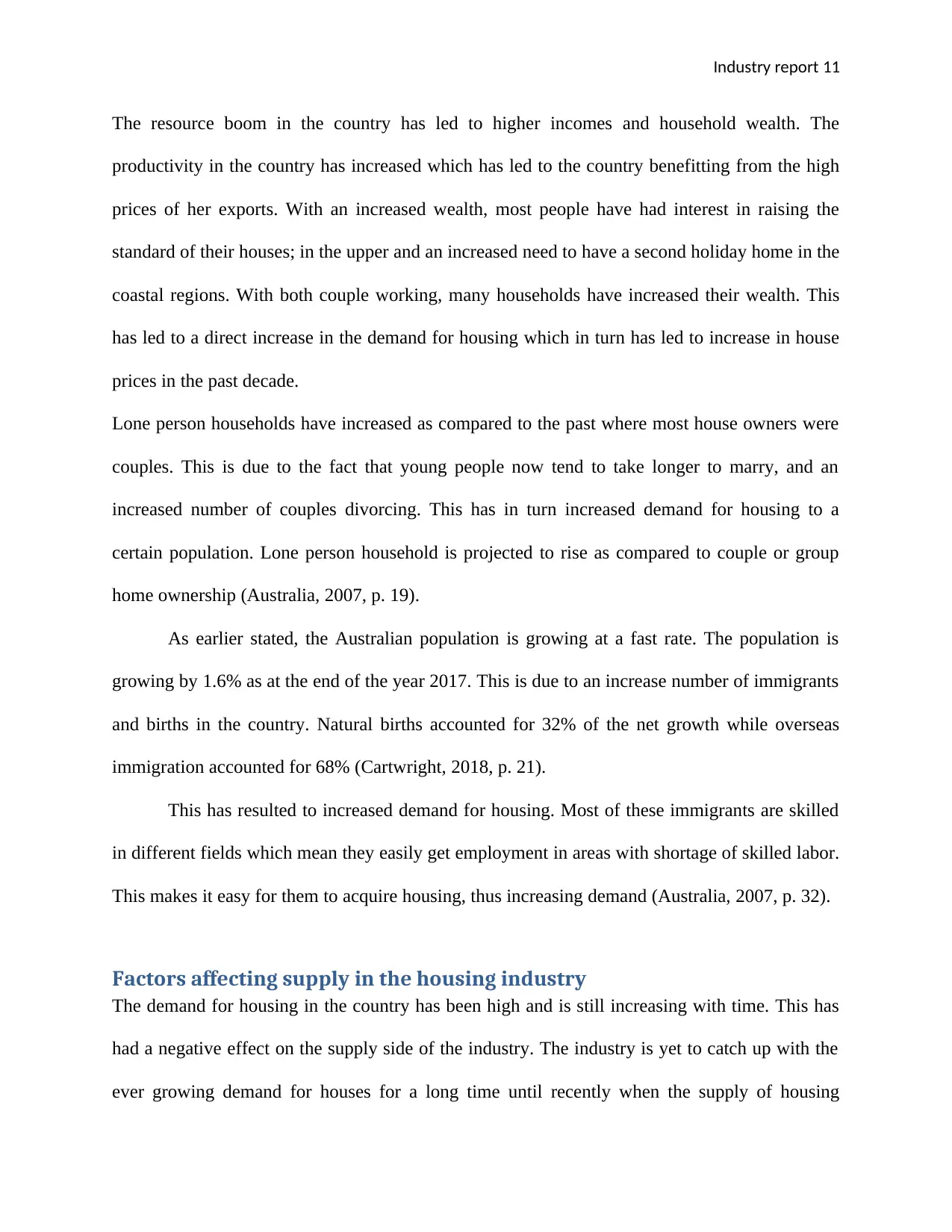
Industry report 11
The resource boom in the country has led to higher incomes and household wealth. The
productivity in the country has increased which has led to the country benefitting from the high
prices of her exports. With an increased wealth, most people have had interest in raising the
standard of their houses; in the upper and an increased need to have a second holiday home in the
coastal regions. With both couple working, many households have increased their wealth. This
has led to a direct increase in the demand for housing which in turn has led to increase in house
prices in the past decade.
Lone person households have increased as compared to the past where most house owners were
couples. This is due to the fact that young people now tend to take longer to marry, and an
increased number of couples divorcing. This has in turn increased demand for housing to a
certain population. Lone person household is projected to rise as compared to couple or group
home ownership (Australia, 2007, p. 19).
As earlier stated, the Australian population is growing at a fast rate. The population is
growing by 1.6% as at the end of the year 2017. This is due to an increase number of immigrants
and births in the country. Natural births accounted for 32% of the net growth while overseas
immigration accounted for 68% (Cartwright, 2018, p. 21).
This has resulted to increased demand for housing. Most of these immigrants are skilled
in different fields which mean they easily get employment in areas with shortage of skilled labor.
This makes it easy for them to acquire housing, thus increasing demand (Australia, 2007, p. 32).
Factors affecting supply in the housing industry
The demand for housing in the country has been high and is still increasing with time. This has
had a negative effect on the supply side of the industry. The industry is yet to catch up with the
ever growing demand for houses for a long time until recently when the supply of housing
The resource boom in the country has led to higher incomes and household wealth. The
productivity in the country has increased which has led to the country benefitting from the high
prices of her exports. With an increased wealth, most people have had interest in raising the
standard of their houses; in the upper and an increased need to have a second holiday home in the
coastal regions. With both couple working, many households have increased their wealth. This
has led to a direct increase in the demand for housing which in turn has led to increase in house
prices in the past decade.
Lone person households have increased as compared to the past where most house owners were
couples. This is due to the fact that young people now tend to take longer to marry, and an
increased number of couples divorcing. This has in turn increased demand for housing to a
certain population. Lone person household is projected to rise as compared to couple or group
home ownership (Australia, 2007, p. 19).
As earlier stated, the Australian population is growing at a fast rate. The population is
growing by 1.6% as at the end of the year 2017. This is due to an increase number of immigrants
and births in the country. Natural births accounted for 32% of the net growth while overseas
immigration accounted for 68% (Cartwright, 2018, p. 21).
This has resulted to increased demand for housing. Most of these immigrants are skilled
in different fields which mean they easily get employment in areas with shortage of skilled labor.
This makes it easy for them to acquire housing, thus increasing demand (Australia, 2007, p. 32).
Factors affecting supply in the housing industry
The demand for housing in the country has been high and is still increasing with time. This has
had a negative effect on the supply side of the industry. The industry is yet to catch up with the
ever growing demand for houses for a long time until recently when the supply of housing

Industry report 12
increased significantly. As noted earlier, the prices of houses have been on a steady increase in
the past decade hitting a record high in mid-2017. After these, the prices started falling and are
now at the same prices as 2016.
In recent years there has been an increased foreign investment in major cities especially from the
Chinese. This has led to the supply side of housing to catch up with demand. This has been one
of the reasons for the falling of prices in the housing sector (Lowe, 2019, p. 18).
Population distribution in the country has also been a factor affecting supply of housing. During
the mining boom in the recent years since 2003 saw an increase in the population in Western
Australia. This boom led to investors responding by building houses in the region. During the
boom, houses built in the region accounted for a big percentage of all houses built in the country.
The supply was catching up with demand but unfortunately, there has been a population shift as
the mining boom started falling (Lowe, 2019, p. 15).
Elasticity
The housing industry is elastic. There has been a drop in the prices of houses in the
country since the last quarter of 2017. This happened in the midst of a high demand for houses
especially in the cities of Sydney and Melbourne. The demand for houses is still high as the
factors such as a growing population are still there. The drop in prices has also led to a growing
demand in houses which means that the industry is still elastic.
With the availability of affordable mortgages, low prices of houses and a good supply of
houses, it means that more buyers are able to buy houses. Incomes in the country are still high as
the economy is still strong, meaning people can afford even more luxurious houses.
increased significantly. As noted earlier, the prices of houses have been on a steady increase in
the past decade hitting a record high in mid-2017. After these, the prices started falling and are
now at the same prices as 2016.
In recent years there has been an increased foreign investment in major cities especially from the
Chinese. This has led to the supply side of housing to catch up with demand. This has been one
of the reasons for the falling of prices in the housing sector (Lowe, 2019, p. 18).
Population distribution in the country has also been a factor affecting supply of housing. During
the mining boom in the recent years since 2003 saw an increase in the population in Western
Australia. This boom led to investors responding by building houses in the region. During the
boom, houses built in the region accounted for a big percentage of all houses built in the country.
The supply was catching up with demand but unfortunately, there has been a population shift as
the mining boom started falling (Lowe, 2019, p. 15).
Elasticity
The housing industry is elastic. There has been a drop in the prices of houses in the
country since the last quarter of 2017. This happened in the midst of a high demand for houses
especially in the cities of Sydney and Melbourne. The demand for houses is still high as the
factors such as a growing population are still there. The drop in prices has also led to a growing
demand in houses which means that the industry is still elastic.
With the availability of affordable mortgages, low prices of houses and a good supply of
houses, it means that more buyers are able to buy houses. Incomes in the country are still high as
the economy is still strong, meaning people can afford even more luxurious houses.
⊘ This is a preview!⊘
Do you want full access?
Subscribe today to unlock all pages.

Trusted by 1+ million students worldwide
1 out of 17
Your All-in-One AI-Powered Toolkit for Academic Success.
+13062052269
info@desklib.com
Available 24*7 on WhatsApp / Email
![[object Object]](/_next/static/media/star-bottom.7253800d.svg)
Unlock your academic potential
Copyright © 2020–2025 A2Z Services. All Rights Reserved. Developed and managed by ZUCOL.